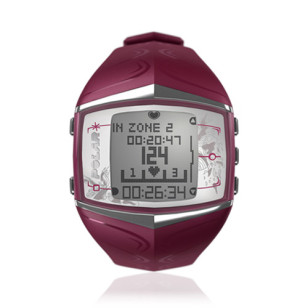One of the greatest training tools I’ve come across throughout the years is my heart rate monitor. I’ve relied on my trusty Polar (I’m currently on my third one, a FT60) for the last six or so years, and I really can’t imagine training without it.
So, why do you need a heart rate monitor? Technically, it’s not a necessity … but it’s a great way to keep track of a number of stats, benchmarks, and numbers that can be crucial if you are truly serious about improving your training and fitness level. They are great for all kinds of training – running, Spinning, group fitness classes, even weight training.
Some of the most common measurements recorded by a heart rate monitor include:
- Heart rate (obviously). Depending on your goals, or the type of training you are focused on each day, your heart rate range may vary. As a general rule, you want to stay between 65% and 85% of your maximum heart rate. However, there are instances in which you may be outside of this range, such as when performing high intensity interval training. Monitoring your heart rate can tell you not only how hard you are working, but can also help you in determining rest times between exercises, sets or intervals.
- Calories burned. Let’s be honest: the calorie counts on your cardio machine are notoriously incorrect. Because a heart rate monitor uses your own biology to determine calories burned – in addition to the information you provide, such as age, sex, height or weight, and possibly resting heart rate or VO2 max – it is a far more reliable number than the averaged calculations displayed on your trusty treadmill. Many heart rate monitors can also sync into your cardio machine of choice, displaying your actual current heart rate, in realtime, right on the machine, without having to hold onto any specific part of the machine.
- Exercise duration. This is a great function if you are an outdoor exerciser – how many times have you gotten home from what feels like a nice, long run, only to find you were only gone 20 minutes? No questions here. Many will even go beyond recording time, listing other factors, such as time spent in each zone, average time in zone, etc. Many will also provide weekly totals, or have the option to review multiple daily or weekly results.
Ready to see what a heart rate monitor can do for you? Consider a few factors before you make the investment. Know what you plan on using it for, and the most important features for you and your goals – there are so many options out there, from the basic model, all the way up to the high-end, GPS-enabled, talking, sync-able model. Also think about what model will be most comfortable for you – the most reliable ones come with a strap that goes around the chest, and a wrist unit, similar to a watch, which ”talks” to the strap and records your data. The strap can take a little getting used to, but after a week or two, it will feel as strange to go without it as it did when you first started wearing it (ladies, it may be a little easier for you to get used to – it almost feels like the bottom of a tight sports bra).
A heart rate monitor really can make a big difference in your workout regimen. By using this gadget to help to track a number of crucial factors – heart rate, calories burned, time in zone, daily/weekly results, and much more – you may find your workouts become more efficient, and you start to see greater results. I can’t even remember what it was like to work out without mine!



Post your comment